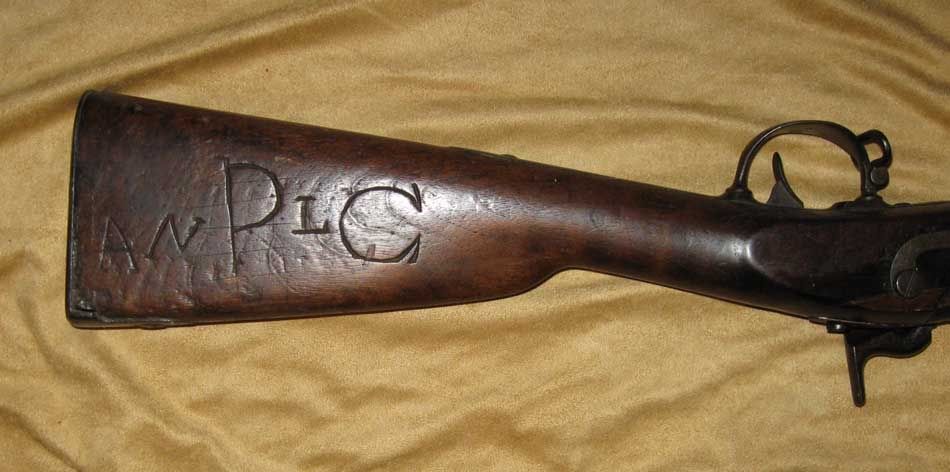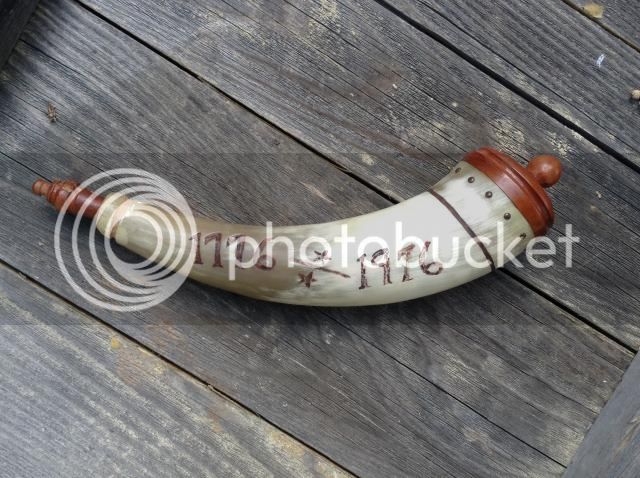You are using an out of date browser. It may not display this or other websites correctly.
You should upgrade or use an alternative browser.
You should upgrade or use an alternative browser.
Powder horn work over
- Thread starter dtalley
- Start date

Help Support Muzzleloading Forum:
This site may earn a commission from merchant affiliate
links, including eBay, Amazon, and others.
newtewsmoke
45 Cal.
yes, if the 1976 isn't scribed too deep and the horn wall isn't so thin that you sand clear thru it. You'll prob. re-finish the whole thing after removing it?dtalley said:Can I sand off the 1976 without hurting the horn.
It is yer horn. Do as ye please. But 1976 was the Bicentennial year we remembered our freedom won to do as we pleased. I think it would be a pity to remove it. 
But, yer horn, yer freedom to do yer thang.
But, yer horn, yer freedom to do yer thang.
Guest
Let’s see.
Open statement:
Why you should do as suggested:
Closing statement:
Nothing about the original question. "Can I sand off the 1976 without hurting the horn."
Question: "Which is better Ford or Chevy?"
Rifleman1776: "I like Toyota."
:rotf:
Open statement:
Rifleman1776 said:It is yer horn. Do as ye please.
Why you should do as suggested:
Rifleman1776 said:But 1976 was the Bicentennial year we remembered our freedom won to do as we pleased. I think it would be a pity to remove it.
Closing statement:
Rifleman1776 said:But, yer horn, yer freedom to do yer thang.
Nothing about the original question. "Can I sand off the 1976 without hurting the horn."
Question: "Which is better Ford or Chevy?"
Rifleman1776: "I like Toyota."
:rotf:
I'd file it off and then sand. You can actually polish horn until it is glossy and then it looks fake- like plastic so sand to glossy and then "go back" with a rougher sand paper to return it to a satin finish. I think the originals were scraped with a piece of glass. Maybe dress up the area near the peg, file the groove better. etc. Some horns have a staple in that area, the strap goes around the horn and the staple helps the horn hang as you prefer. If you can pull the brass nails and put in square iron/steel nails, probably be good.
S.Kenton
58 Cal.
I think you'll be fine filing off the 1976 without making a hole..and I don't blame you for wanting to do so... you might also consider reshaping the pour spout of the horn as well..looks a little thick. That's my 2 cents..take it for what it's worth!...I'd like t see it after your done, looks like a fun project!
- Joined
- Jun 12, 2005
- Messages
- 8,027
- Reaction score
- 1,031
my two cents:
yes, it appears that there's enough material, so you can probably sand the "1976" off the horn.
Here's another option: get a copy of this book:
http://www.trackofthewolf.com/Categories/PartDetail.aspx/76/1/BOOK-R18CPH
Recreating the 18th century Powder Horn, by Scott and Kathy Sibley ... a great book.
Now the warning / disclaimer: you will be 'bitten' after about the first twenty minutes of hornmaking ... this is easy, not very expensive, provides you with a product which looks pretty cool, and next you know, you'll be having a great time making a horn for each gun, (Whatever do you mean, "I only have one gun"??!! - that's easy to fix, too!)
either way you decide to go, I wish you the best of luck with your project!
yes, it appears that there's enough material, so you can probably sand the "1976" off the horn.
Here's another option: get a copy of this book:
http://www.trackofthewolf.com/Categories/PartDetail.aspx/76/1/BOOK-R18CPH
Recreating the 18th century Powder Horn, by Scott and Kathy Sibley ... a great book.
Now the warning / disclaimer: you will be 'bitten' after about the first twenty minutes of hornmaking ... this is easy, not very expensive, provides you with a product which looks pretty cool, and next you know, you'll be having a great time making a horn for each gun, (Whatever do you mean, "I only have one gun"??!! - that's easy to fix, too!)
either way you decide to go, I wish you the best of luck with your project!
Last edited by a moderator:
You could go the other way:
Make the horn really bicentennial and sell it as such, maybe to someone born in 1976. Maybe carve the reverse of the bicentennial quarter on it, add a set of crossed muskets, or the opening of the Declaration of Independence could be scrimmed onto it.
If you sell it you could start to finance your way into the hobby, with the hobby!
Make the horn really bicentennial and sell it as such, maybe to someone born in 1976. Maybe carve the reverse of the bicentennial quarter on it, add a set of crossed muskets, or the opening of the Declaration of Independence could be scrimmed onto it.
If you sell it you could start to finance your way into the hobby, with the hobby!
- Joined
- Jul 7, 2007
- Messages
- 2,657
- Reaction score
- 13
I've made a few horns in my time and just by looking at your photo. I'll tell you that the 1776 along with that white area will sand off and you will end up with the darker color of that horn coming through in no time. If you note where the butt plug and horn meet under those tacks. The color came through dark from the maker sand the horn to wood flush. __ That's a Holstein cow horn and sanding gets tricky sometimes. Don't ask me how I know that!
Good luck
Good luck
I would think about getting a book on building powder horns. The steer horn will likely be oval in shape, you can make a plug to fit that way but to do a better job you need some "test" plugs that are tapered and various sizes. You want to boil (fry baby works) the end of the horn to soften it and then put in a plug that fits. Snug but not tight, too tight and you get a ring or bell around the horn as it cools. Remove the test plug and then turn the final plug on a lathe, and if you want "rope", teeth, etc. then hand carve that part.
Making powder horns is not too expensive, I even built my own lathe using ball bearings, hand held drill for a motor, etc.
Making powder horns is not too expensive, I even built my own lathe using ball bearings, hand held drill for a motor, etc.
- Joined
- Jul 7, 2007
- Messages
- 2,657
- Reaction score
- 13
dtalley said:Thanks for all the replies. I am undecided at this time but I am going to get a sanded steer horn ordered and build one myself.
horner75 said:I've made a few horns in my time and just by looking at your photo. I'll tell you that the 1776 along with that white area will sand off and you will end up with the darker color of that horn coming through in no time. If you note where the butt plug and horn meet under those tacks. The color came through dark from the maker sand the horn to wood flush. __ That's a Holstein cow horn and sanding gets tricky sometimes. Don't ask me how I know that!
Good luck
Didn't you mean to say "1976" in your post?
It looks like the "1776" is already in the layer under the white area? :hmm:
- Joined
- Jul 7, 2007
- Messages
- 2,657
- Reaction score
- 13
Your right Jim!....My bad! :wink:
I defer to the horn experts here so I'm just "thinking". In the photo posted, the numbers, etc. look like they are fairly deep into the horn. Is that pc? I thought scrimshaw was rather shallow into the horn and the lines rather thin. If the whole thing can be taken off- seems that might be best.
I think your right and there is no doubt this horn was made in modern times.
That said, some pretty crusty carving has been done by the novice over the years.
An example of this is the initials carved into the stock of my 1842 Springfield smooth bore musket.

I have no idea who did this or when it was done.
Probably sometime after the end of the Civil War because even then, the military took a dim view of men carving on Government owned weapons. :grin:
That said, some pretty crusty carving has been done by the novice over the years.
An example of this is the initials carved into the stock of my 1842 Springfield smooth bore musket.

I have no idea who did this or when it was done.
Probably sometime after the end of the Civil War because even then, the military took a dim view of men carving on Government owned weapons. :grin:
- Joined
- Jul 7, 2007
- Messages
- 2,657
- Reaction score
- 13
For what it's worth. Sometimes there is a fine line between what is called scrimshaw and what is called engraving. This is apparent in powder horns art. There are many examples of original horns with deep cut engraving, but also many more examples of horns with the more familiar scratch cut etching. Both are correct, as it was a matter of the person making the decoration on each horn.
Rick
Rick
Similar threads
- Replies
- 6
- Views
- 688
- Replies
- 4
- Views
- 652
- Replies
- 3
- Views
- 438
Latest posts
-
-
-
-
-
-
Anybody here proficient in making Plains war shirts? (Need help)
- Latest: Flintlock Fellow
-
-




